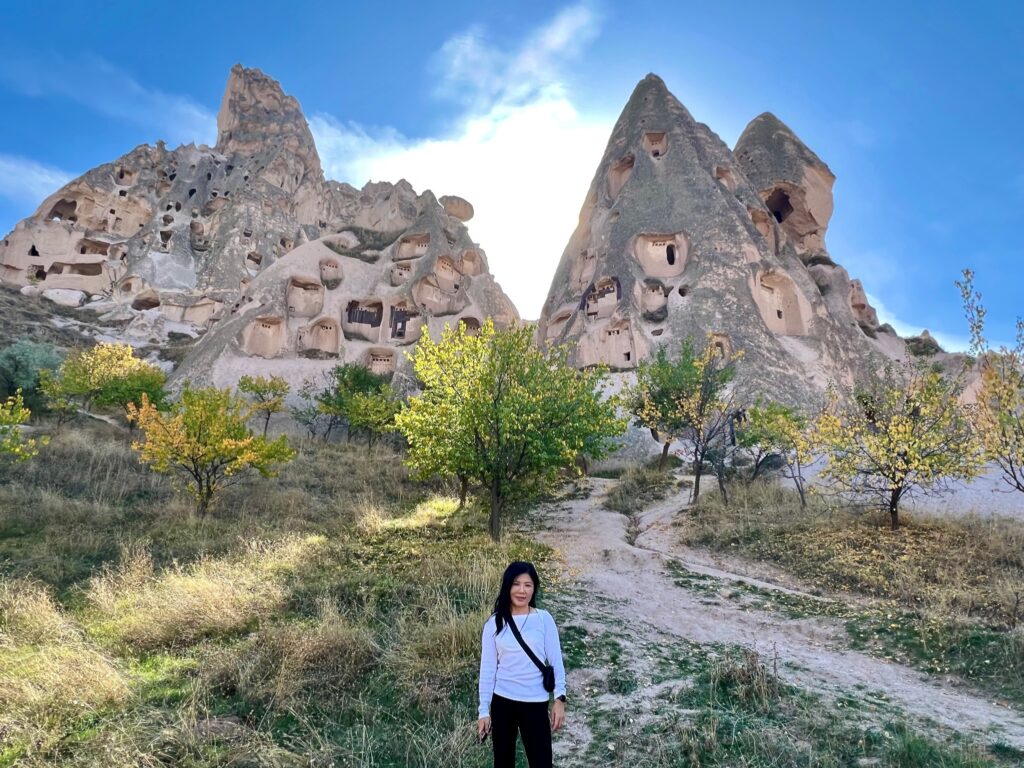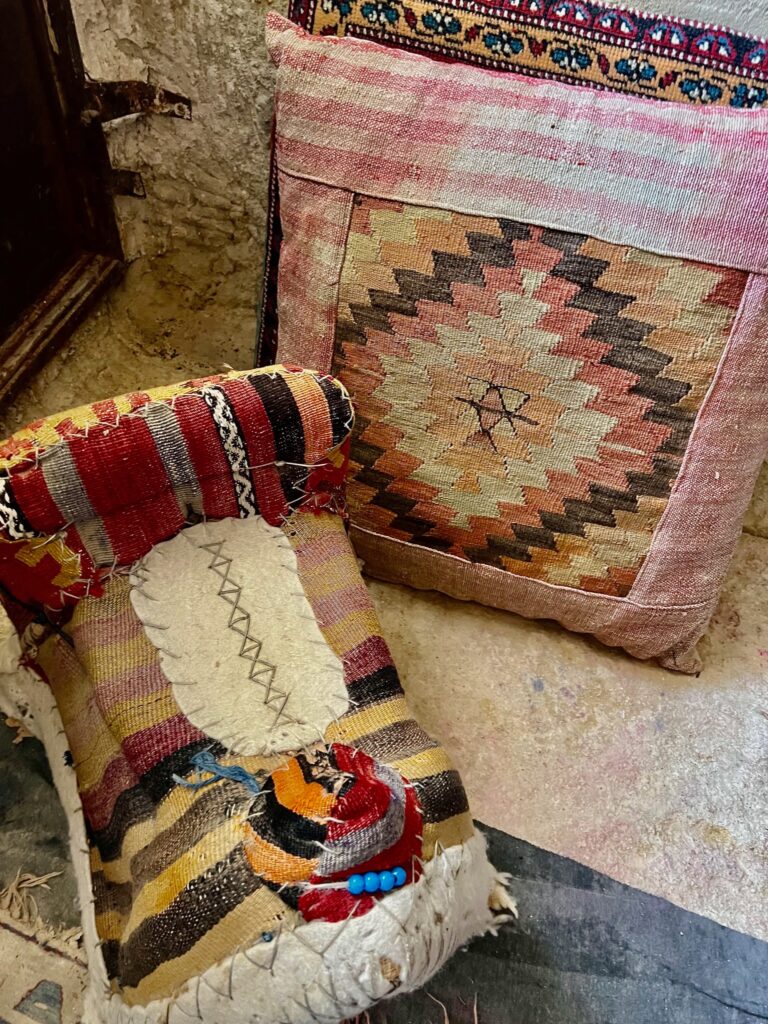After returning from Slovenia, we have been enjoying Novi Sad, exploring restaurants, hosting vintage movie nights and meeting new people. Our friend Iva took us to the “American Corner” where we participated in a debate about America’s 2nd Amendment “the right to keep and bear arms.” The Serbian take on private gun ownership is interesting and very different then the USA’s. Serbia does not allow private hand guns or assault weapons but they do allow hunting rifles / shot guns. Additionally, Serbia taxes gun ownership to dissuade ownership and most people do not own a gun. This approach would spark a second revolution in America and I respect Serbia’s right to determine its own gun policies.
Cappadocia, Turkey
Imagine a cross between the Grand Canyon, Monument Valley with a hint of Harry Potter and a lot of Turkish charm, and you have Cappadocia. Per Google, Cappadocia, a semi-arid region in central Turkey, is known for its distinctive “fairy chimneys,” tall, cone-shaped rock formations clustered in Monks Valley, Göreme and elsewhere. Other notables sites include Bronze Age homes carved into valley walls by troglodytes (cave dwellers) and later used as refuges by early Christians.
Taskonaklar Hotel
We stayed at the Taskonaklar Hotel located across from the Pigeon Valley. Did you know that in Turkey, they raise Pigeons for their poop? I kid you not! Apparently Pigeon Poop is very high in minerals, is an excellent fertilizer, and each kilo sells for six euros. Personally, I am happy with MiracleGrow and wouldn’t do this. So back to our hotel, such a nice place, very rustic and we slept in a cave room.



The Turkish Breakfast is insanely delicious and filling. The fresh baked pastries, upper left, changed daily and the Turkish Coffee and Tea really have a kick. We liked to dine on the terrace as the weather was so nice and the views spectacular.

Day 1 – Balloon Ride, Cave House, Uçhisar Castle, the Carpet Cooperative and Kaymaklı Underground City
Our first event, at 5:30 AM was the Balloon ride. Cappadocia flies over 165 balloons daily and generates 4 ~ 5 million euros weekly from ballon tourism; at least when the wind isn’t too strong. We were extremely fortunate that the weather cooperated for our flight, as the rest of the week all ballon flights were cancelled. Each ballon can hold up to 25 tourists, in segmented basket sections, with two pilots. We arrived very early and watched the balloon inflate. Our balloon was filled with super excited Malaysian tourists and off we went. Lift-off was very smooth and we quickly rose above the canyon; maximum height of 320 meters or just over 1000 feet. Watching all the other balloons fly is really magical, and we especially liked when the burners ignited and the ballon glowed orange. Other than people noise, it is very quiet, until the burner ignites and then imagine being next to a loud blow torch. Having flown in Sedona, Arizona, I can say this was much better and was perfect.



After the balloon ride, we went to the Esentepe Valley to visit a cave house. Cave homes take roughly four days to carve the basic structure, and do not have running water or indoor plumbing. Most have a single room for living, sleeping and eating with a small kitchen area. Fancier structures have separate sleeping quarters for the parents. The good news is that the cave homes maintain a constant 16C or 62F year round, and in the winter a single wood burning stove is all that is needed to keep the house warm.
Uçhisar Castle is a tall volcanic-rock outcrop and the most prominent landmark in Cappadocia. It is riddled with tunnels and was used for centuries by villagers as a place of refuge when enemy armies overtook the surrounding areas. It also served as a fortress and barracks against the Romans, and is a great example of cave dwellings.


Carpet weaving remains a key part of Turkish life and many of the carpets are over a 100 years old.



To preserve the rug weaving tradition, the Turkish Government established cooperatives and even offers free looms to women that complete basic courses; don’t shoot the messenger – women make the rugs and the men sell them. We visited a Carpet Cooperative and saw over 100 examples of rugs. I had no idea that rugs are made of wool, silk, cotton and everything in between. A good rug made by one person takes over 3 months per square meter to weave, and is often based on family designs handed down through the generations. We purchased a rug and can’t wait until it arrives home. Pictures to come!


The final stop was to the Kaymaklı Underground city. I know the term Underground City sounds cool, but believe me it was a scary place. Used by the villagers to hide from invading Romans, the city in Cappadocia could house 5,000 people, typically lasting for 10 days or until the invaders left. Kaymaklı Underground city has 8 levels with no running water or bathrooms. Human waste was disposed of in the lowest levels, and once the city was closed you stayed there with your animals. Our guide shared that during these stays, people drank a lot of wine as a natural anti-anxiety medicine. I personally can’t image 5,000 people all trapped in a cold dark cave for up to 10 days!


Day 2 – Cooking Class at Ayvali Village, Hike at Meskendir Valley and Çavuşin Village
After another huge Turkish Breakfast (we really shouldn’t have, but it was too good), we visited the Duran family’s home to learn how to make Turkish cuisine. I admit this was kind of weird to us as “who goes on vacation to make their own food?” and I am happy we did. Mr. Duran welcomed us to his home and introduced his mother, wife and sons. This is a family business and both boys are studying to become chefs like their father. I can drone on and on about the experience, so long story short, the food was delicious, the hospitality wonderful, and we came away with excellent memories and a family recipe book that we will put to good use.









After another huge meal, we hiked the Meskendir Valley. Our hike was slow and meandering with time to explore. We enjoyed the unhurried pace and the chance to look in the cave homes. A lot of the “cave homes” were small family Chapels, as the Romans persecuted the Christians back in the 2nd AD. As the pictures show, the landscape is very rugged with lots of Fairy Chimneys, Chapels and natural Arches.



We completed our hike at Çavuşin Village, and saw the most amazing example of “Cave Home Apartment.” Greeks lived in Turkey for generations, and built and lived in the apartment complex below. However, in 1923 the Greeks and Turks living in the respective countries were forced to repatriate. The population exchange between Greece and Turkey stemmed from the “Convention Concerning the Exchange of Greek and Turkish Populations” signed at Lausanne, Switzerland, on 30 January 1923, by the governments of Greece and Turkey. This action caused issues for the impacted peoples as they didn’t share the language and customs of their new country — History does tend to repeat itself.

Day 3 – Jeep Safari, Göreme Open Air Museum and the Whirling Dervishes ceremony at historical Saruhan Caravanserai
Day 3 started with an adrenalin shot courtesy of our Jeep Safari. We boarded a circa 2000 Land rover Defender and headed off to the dessert. Our driver spoke some English and treated us to slides, swerves and curves. On one of the inclines my passenger side window was on a 60 degree angle and the dirt road was a mere meter away. Lots of fun and little did we know the guy was a savant when it came to taking pictures and videos. What was also great about the tour is he took us to some hiking trails where we saw beautiful stone chapels and amazing rock formations.




The Göreme Open Air Museum is a vast monastic complex composed of scores of refectory monasteries placed side-by-side, each with its own fantastic church. Personally, I found it difficult to understand how people would willing sequester themselves from everything and live in the caves while pursuing their religions studies everyday. That being said, this was a place of great learning and offered some of the nicest frescos. Unfortunately, they don’t allow pictures so here are some from Google.




Whirling dervish ceremonies were started as a form of meditation by Jalaluddin Rumi, the famous Sufi Muslim mystic and poet, in the 13th century. This ceremony begins with a musical recitation of a verse from the Quran by a hafiz, a scholar who has learnt the Quran by heart. This is followed by an improvisation on a ney reed flute, accompanied by the deep boom of a kettledrum.
The dervishes are then led around the ceremonial hall by their master, before removing their black cloaks as a symbolic act of deliverance from worldly connections.
One by one, the dervishes begin their dance, starting with their arms folded across their chest and gradually raising right arm to Heaven, while the left points toward the ground. In this position the dervishes whirl, trancelike, around the hall in four salams, which represent the progressive journey each believer goes through, from recognition of God to the ecstasy of the surrender to divinity and peace of the heart.
The ceremony is concluded by a final recitation from the Quran and a prayer by the dervish master. We found the ceremony to be spiritual and the music soothing. I am glad we went and would recommend the experience to anyone visiting Cappadocia.
The Whirling Dervishes ceremony is held in the historical Saruhan Caravanserai. This is where the Silk Road traders would stop to rest both themselves and their camels. Camels can only travel 40 kilometers a day, so there are a series of Caravanserai dotting the entire Silk road.


Day 4 – Paşabağ Valley, Devrent (imagination) Valley and the Pottery Workshop at Avanos
By Day 4 we were starting to feel the whirlwind pace. We started the morning at 11:00 and went to two of the valleys. Each provided great examples of chimneys and cave homes. The Devrent valley had a lot of cool rock formations that set your mind free to wander. Each valley offered ample opportunity to explore and we even witnessed Instagram Influencers in the wild going crazy with wardrobe changes. It is so true that for every Instagram Influencer, there is a suffering boyfriend / husband forced to be a human selfie stick.







Our final stop was to the Pottery Workshop at Avanos. We met the multi-generational family that owns the shop and witnessed them throwing, shaping, painting and firing traditional and modern clay pieces. The shop is underground and spans over 1000 meters. We purchased two very nice pieces, that we had shipped and will share photos once they arrive.

Our guide took us to an everyday restaurant that serves a stew cooked in a traditional clay pot. What made this unique to us is that the stew cooks for two hours in a sealed pot, that has to be broken to release the stew. Seems kind of wasteful to break pots each time to eat, but it was a tasty meal.

Final Thoughts
Visit Cappadocia and enjoy all it has to offer. Warm hospitality, great food and amazing vistas. We didn’t know exactly what to expect prior to the trip as pictures on the Internet can be so deceiving, so we are very happy that the reality exceeded the hype. Also, for Americans the USD goes a long way and Turkey provides a lot of value. We liked it so much that we are planning on a vacation next June/July to the Aegean and Mediterranean Coasts.
I would also like to thank Gudrun Updegraff from Audley Travel who created our itinerary and Uygar Emte Aras from Unveiled Anatolia who acted as our tour guide. Gudrun and Aras ensured we had the very best time possible, and we really appreciate everything they did.





